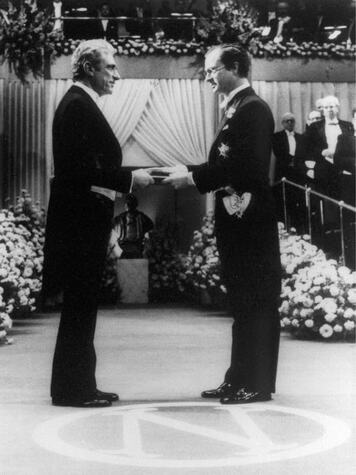personal data
Steinberger Hans Jakob, Prof.
Parents: Ludwig and Bertha Steinberger née May
Siblings: Herbert and Rudolph Steinberger
Spouse: Joan née Beauregard (first marriage) and Cynthia née Alff (second marriage)
Children: Joe and Ned (from first marriage) - Julia and John (from second marriage)
Promenadestraße 2 (today's count)
December 1934 emigrated to the USA
biography
Hans Jakob Steinberger was born on May 25, 1921 as the son of Ludwig Steinberger and his wife Bertha in the Jewish Community House in Bad Kissingen. His father, who had been born in Schonungen in 1874, was the son of a small cattle dealer and had seven siblings. After his education, Ludwig Steinberger worked in Bad Kissingen since 1892 as the Cantor and Teacher of Religious Education in the Jewish Community. Shortly after World War I, the 45-year-old man married Bertha May, who was 18 years his junior. She came from the prosperous family of a Nuremberg hops dealer. She had finished studies of English and French at university accompanied by stays in London and Paris, an uncommon privilege in those days.
Ludwig and Bertha Steinberger had three children: The oldest son Herbert was born in Bad Kissingen in 1920. Hans Jakob (Jack) followed in May 1921 and Rudolph in May 1924. The family lived in the Jewish Community House in Promenadestrasse next to the Synagogue in modest circumstances, “carefree but not luxurious”. Jack and his two brothers grew up protected and got a good middleclass education. Music played an important role in the family, too.
Between 1931 and 1934, Hans Jakob and Herbert attended Kissingen Realschule which was a 6-class predecessor of the contemporary grammar school. Even in those early days, Jack Steinberger’s reports were promising: “Rather well gifted; the student knows answers when the rest of the class fails.” Class teacher Zwick attested to the later Nobel Laureate “good ideas, intuition, logical thinking, diligence and a sense of duty” but also a certain “inclination to chattering”. His classmates described him as a happy little rascal ready to play pranks. In his free time, Jack roamed through the nearby forests with his friends or played football with them on the lawn behind the synagogue.
This carefree, happy time for the Steinberger family found an abrupt ending after the seizure of power of the National Socialists in 1933. Jack Steinberger still remembers anti-Semitic election posters with horrible caricatures of repulsively presented Jews and the nightly rallies of SA through the streets of the town. “I remember nightly torch marches of the brownshirts of SA before Hitler’s “seizure of power”. They sang the “Horst-Wessel-Lied” with its chorus: ‚Wenn’s Judenblut vom Messer fließt, dann geht’s nochmal so gut.‘ (When Jewish blood flows from the knife, then it works twice as good.’ They carried daggers at their belts.” Already in 1934, Jack’s parents realized how earnest the situation was and made up their minds to send their two oldest children to a place where they were safe from Nazi terror. They accepted an offer of a Jewish charity organization in the USA to have 13-year-old Jack and his 14-year-old brother Herbert taken to the United States with a transport of 300 Jewish children on board the steamer “Washington”.
In December 1934, Jack Steinberger started his journey to America together with his older brother Herbert Lazarus. Jack Steinberger comments in retrospect: “It was not easy for a family to send their children away. We didn’t have any relatives outside Germany to whom we could have gone.” After difficult weeks in the USA at the beginning, the children were taken up by Barnett Faroll, a corn dealer in Chicago. He didn’t only provide a good education for the two of them, but in 1937 also made it possible for Jack’s parents and his younger brother Rudolph to emigrate to the USA. The family bought a small delicatessen shop in Chicago, the profits of which allowed them only a very scanty life.
Young Jack Steinberger also owed his high school education at the renowned New Trier Township Highschool in the wealthy suburb in the North of Chicago to his foster father Barnett Faroll. After his graduation, Jack Steinberger went to the Armour Institute of Technology in order to become a chemistry engineer. After two years, his scholarship ended in 1941 and Jack had to interrupt his studies in order to start working. His experiences when looking for a job in the hard times of the economic crisis are described by Steinberger as the “most depressing” ones he ever had. For example, he cleaned chemical appliances in a pharmaceutical laboratory for 18 dollars a week… Fortunately, he got a scholarship by the University of Chicago and could finish his studies of chemistry in 1942.
In the same year – the USA had entered the World War in the meantime – he volunteered for military service and took part in a short course on electronics and electromagnetic waves there. This was Jack Steinberger’s first contact with physics which wouldn’t release him ever after. Steinberger was transferred to the Massachusetts Institute of Technology (MIT) Radiation Laboratory in Boston. There he contributed to the development of radar systems for the nightly bombing raids of the Allied Forces till the end of the war and had the chance of taking part in basic physics courses that became the basis for his career as a physicist after the war. That Steinberger sees his “war work” in a definitely ambivalent way can be guessed from several interviews he gave: On the one hand, he knows that he found to physics that way, his real calling. On the other hand, he declares that because of his participation in the development of the radar system, he has a responsibility for the deaths of many civilians during the nightly bomb raids. He emphasizes that bomb raids like the one on Dresden in 1945 were unjust.
After the end of the war, Steinberger started to study physic at the University of Chicago with famous professors such as Enrico Fermi, W. Zachariesen and Edward Teller. He had an especially high esteem for Fermi, not only because of his courses which he described as “real gems of simplicity and clarity” but also because he cared for his students even outside the teaching program of the university. In 1948, Steinberger wrote his doctoral thesis under supervision of Fermi not – as he had initially wished to – on a theoretical topic but on an experiment monitoring the daughter products of the myons contained in cosmological radiation. Fermi had suggested it as no theoretical topic could be found. In his graduate thesis, Jack Steinberger proved that myons, contrary to the opinion prevailing in those days, disintegrate into three components: probably into one electron and two neutrinos. Already in his doctor’s thesis he had thus moved into the direction of experimental studies on neutrinos, something absolutely new in those days, which were to determine his further life as a scientist. After finishing his doctoral thesis, at the end of 1948, Steinberger changed to the Institute for Advanced Study in Princeton for one year, which was headed by Robert Oppenheimer, and then became a scientific assistant at the University of California in Berkeley. There, the experimental opportunities provided by the worldwide most modern particle accelerator that had just been finished fascinated him.
Admittedly, this year also brought about an unpleasant development for the particle physicist who had become well-known in the meantime. In the following years, during the McCarthy Era, who used the Cold War in order to fight against alleged Communists, Leftist Liberals and Socialists, he became a target for rightwing politicians because of his political engagement and his leftist views. When he was prompted one year later to sign an assertion never to have been a member of the Communist Party, he refused to do so. This was one of the reasons why he didn’t get another post at Berkeley. In his opinion, the anti-Communist hysterics of the McCarthy Era meant a bad turn of American politics and an attack on political freedom in America. The young physicist didn’t want to give in to this political pressure although he was afraid of disadvantages of that step for his scientific career. He also ignored the “partisan mentality” prevailing during the Cold War and was looking for a continuous dialogue with scientists in many countries of the earth. He went on tours through the Soviet Union and China on behalf of science.
In 1950, he went to Columbia University in New York where he became a Professor of Physics. In the course of the following years, he undertook several experiments with the just newly devised bubble chamber, a detection device for elementary particles.
In 1962, Jack Steinberger, Leon M. Ledermann and Melvin Schwartz at ‘Brookhaven National Laboratory’ (USA) performed the famous experiment with the high energy neutrino beam that would get them the Nobel Prize of Physics 26 years later. In this experiment, they proved that at least two types of neutrinos existed, the electron neutrino and the myon neutrino. The experiment did not only lead to the detection of a new elementary particle, but it also became the starting point of a new theory. It became evident that the more than 100 known elementary particles obviously belonged to families that normally occur in pairs. By means of the neutrino experiment, basic knowledge of the basic components of matter and the carriers of forces was gained.
In 1968, Jack Steinberger became a member of staff at CERN, the European Laboratory for Elementary Particles in Geneva. Since then, he headed a number of important experiments in the field of particle physics. He became the spokesman of the so-called ALEPH experiment, in which 400 physicists of 30 universities took part. The accelerator purpose-built for this experiment - a monumental tunnel of 27 km length - made fascinating insights into the world of particles possible since its completion in summer 1989. In 1986, Steinberger officially retired at CERN but continued working in various research projects and accepted a part-time professorship for Physics at Scuola Normale Superiore in Pisa.
In 1997, the Faculty of Physics and Astronomy at Julius-Maximilians-Universität in Würzburg awarded him the Honorary Doctorate for Physics in appreciation of his life’s work and his special merits in his service for research and education.
Jack Steinberger always preserved his curiosity. As a kind of background counsellor, he accompanied research at CERN till the 1990s and continued to be interested in the latest findings of his colleagues. After elementary physics had developed into an increasingly more complex apparatus physics, Jack Steinberger turned to cosmology and astrophysics.
Jack Steinberger hasn’t only won a reputation as a physicist. He vehemently engaged himself for Nuclear Disarmament for many years. Again and again, he prompted American presidents from Ronald Reagan to George Bush to Bill Clinton and George W. Bush to start Nuclear Disarmament. Apart from nuclear disarmament he committed himself to solar thermal energy systems which he regarded as the only chance of successfully counteracting the menace of climate catastrophe. In 2009, he presented his proposals for climate protection at a meeting of Nobel Laureates and top researchers in London, which was internationally observed.
In his private life, Jack Steinberger’s most ardent passion is music, in particular the works of Johann Sebastian Bach. For many years, he played the flute and played chamber music with colleagues and friends. Up to a very high age, he loved playing tennis and mountaineering, going by bike and sailing.
In the course of his life – as Steinberger himself says – he has founded two families. The first one took place at the end of 1942 when he married Joan Beauregard. She was born in 1920 in De Pere as the daughter of an immigrants’ family of French descent. In November 1946, Joe Ludwig, the Steinbergers’ first son, was born. He is living in Rockland/ Maine these days and works as a defense lawyer. He also manages the economic side of the management of the Sushi Restaurant he runs together with his wife Suzuki. The second son of the Steinbergers, Richard Ned Steinberger was born in Princeton in November 1948. He became famous in the 1980s as a designer and constructor of avant-garde electric guitars and basses. In the meantime, he has turned to more types of extraordinarily designed electronic string instruments. For his uncommon new ideas in designing, Ned Steinberger got many national and international awards and prizes.
After his divorce from his first wife Joan, in November 1962, Jack Steinberger married his former student Cynthia Alff who had grown up in Queens/ New York. Her mother came from a family of Swedish immigrants and her father had German ancestors. Cynthia Steinberger finished her studies of physics with her doctorate at Brookhaven National Laboratory in 1963 and changed from physics to molecular biology in summer 1966. Because of Jack Steinberger’s moving to CERN, the family made their home in Geneva in 1968, where Cynthia got a teaching position for Molecular Biology at the University of Geneva and could continue her studies in the following years. In 1974, their daughter Julia was born, three years later their son John Paul followed.
Julia Steinberger studied physics and got her doctorate in the USA but then she turned her attention to political, social and ecological concerns. Later she taught and did research as an Associate Professor of theoretical Informatics and Industrial Ecology at Leeds University and lived in Manchester with her family. Her brother John Steinberger successfully finished his Master of mathematics at Waterloo University in Canada and then moved to the University of California in Davis, where he got his doctorate. Since 2007, he has been an associate professor of theoretical informatics at the Institute of Interdisciplinary Information Sciences of the Tsinghua University in Beijing.
The older he got, the more aware of his attachment to his cultural roots the cosmopolitan Jack Steinberger seemed to have become during his visits to his former hometown. That this rapprochement to his cultural roots became possible also has its reason in the fact that in 1989, after having become a Nobel Laureate, Steinberger accepted the invitation of his hometown and went there for a visit.
Among all the honors the modest Laureate received the invitation to his place of birth Bad Kissingen seems to have moved him in a special way. It was surely not easy for him to return to the town and be welcomed with honors, from which he and his parents and siblings had been expelled in such an inhuman way. That he followed the invitation nevertheless and set a sign of reconciliation with his visit in June proves his great strength of character. The prominent son of the town who radiated personal sovereignty in his reserved, modest and human manner deeply moved everybody who met him on this occasion. The way the famous honored guest was received in the hall of Bad Kissingen grammar school is unforgettable. With his uncomplicated way of behaving and his sense of humor he won over the hearts of the teachers and students of his former school.
Since then, he and his wife Cynthia, but also his children intensely kept in touch with Bad Kissingen. He met old friends and acquaintances there such as Joske Ereli (Hans Josef Ehrlich) and made new friends across age groups. For his Kissingen friends, it had always been a great pleasure to go on excursions in Bad Kissingen’s vicinity with him and his family and show him the cultural and scenic beauties of his Franconian home region or to enjoy his company as a straightforward, lovable guest with a great sense of humor when meeting him at a comfortable gathering after a Franconian dinner. He was a wonderful person who kept his openness and curiosity well into his old age, who talked animatedly of historical, political and social topics and enjoyed asking critical, surprising questions when superficial answers didn’t convince him.
During his numerous visits at his former school, Steinberger always sought contact to the younger generation and held lectures for students and teachers on interesting aspects of science such as his work at CERN, Supernovae, cosmic background radiation, the future of our power supply or exposed himself to the students’ questions as a contemporary witness.
In March 2006, Bad Kissingen awarded Honorary Citizenship to the 85-year-old former fellow-citizen.
On the occasion of his 80th birthday, in 2001, Bad Kissingen grammar school had been named after its former student Jack Steinberger. This had made a special permit of the Bavarian Ministry of Culture necessary as Bavarian grammar schools may not be named after living persons on principle. With his sense of humor and his typical quick-wittedness the “patron saint” commented on this honor: “The great honor puts me into great embarrassment. I feel guilty that the name of my small Realschule now has become so inordinately long. But I am happy to be allowed to survive this naming thanks to the appreciation of the Bavarian Ministry.”
On December 12, 2020, Jack Steinberger passed away peacefully in Geneva at the age of 99.
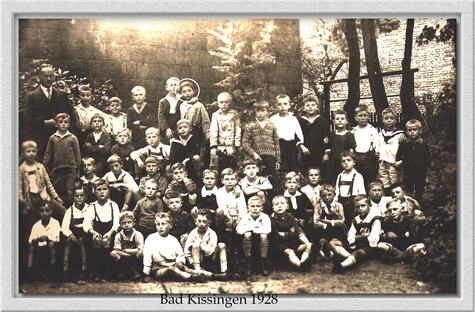
|
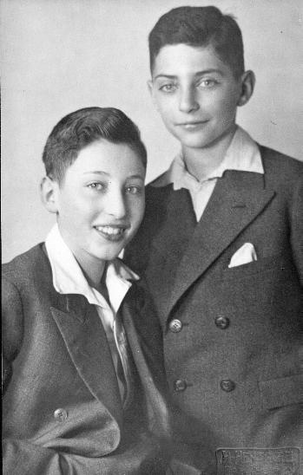
|
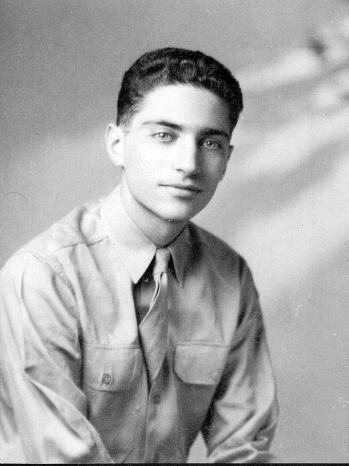
|
|
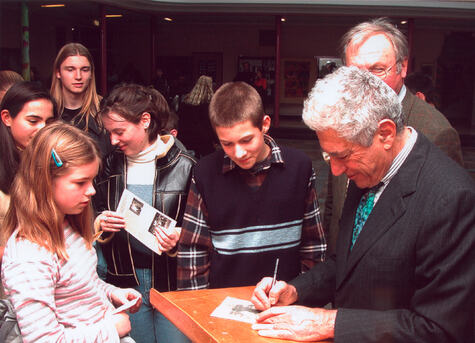
References
Rudolf Walter in: Beck/Walter, Jüdisches Leben in Bad Kissingen, S. 188-192
Hans-Jürgen Beck, Kissingen war unsere Heimat, Stand April 2017, S. 815ff
Rudolf Walter, Jack Steinberger - vom Kantorensohn zum Nobelpreisträger
Wikipediaartikel![]()
Homepage nobelprize.org![]()
Interview mit SZ-Magazin 11/2013![]()
CERN Courier, Paola Catapano, CERN, Neutrino pioneer - an interview with CERN's Jack Steinberger, 08.07.2016![]()
Gerhard Jochem, Prof. Jack Steinberger Nobelpreisträger für Physik 1988, Rijo Research Website, 2010![]()
Interview mit Professor Jack Steinberger im Rahmen der Auricher Wissenschaftstage 2002![]()
Charles D. Ferguson: A Conversation with Nobel Laureate Dr. Jack Steinberger![]()
Ican (International Campain to abolish nuclear weapons)![]()
Steinberger Eighties Guitars![]()
Wikipedia Steinberger-Gitarren![]()
Die stillen Stars (The silent stars) - Jack Steinberger, ZdF-Sendung mit Frank Elstner
Auswahl von Videos über Jack Steinberger im Netz:
DOCUMENTARY - Nobel Prize Winner Jack Steinberger | Smithsonian Museum film by Creutz/Hollander![]()
Jack Steinberger shares his childhood experiences![]()
Interview: Jack Steinberger über erneuerbare Energie, Mai 2016![]()
Photo credits
Klassenfoto © Ursel Pfeiffer
"Autogrammstunde" in der Aula © Jack-Steinberger-Gymnasium
alle anderen Fotos © Jack Steinberger
Video "Die stillen Stars" © ZdF-Sendung mit Frank Elstner
Back
